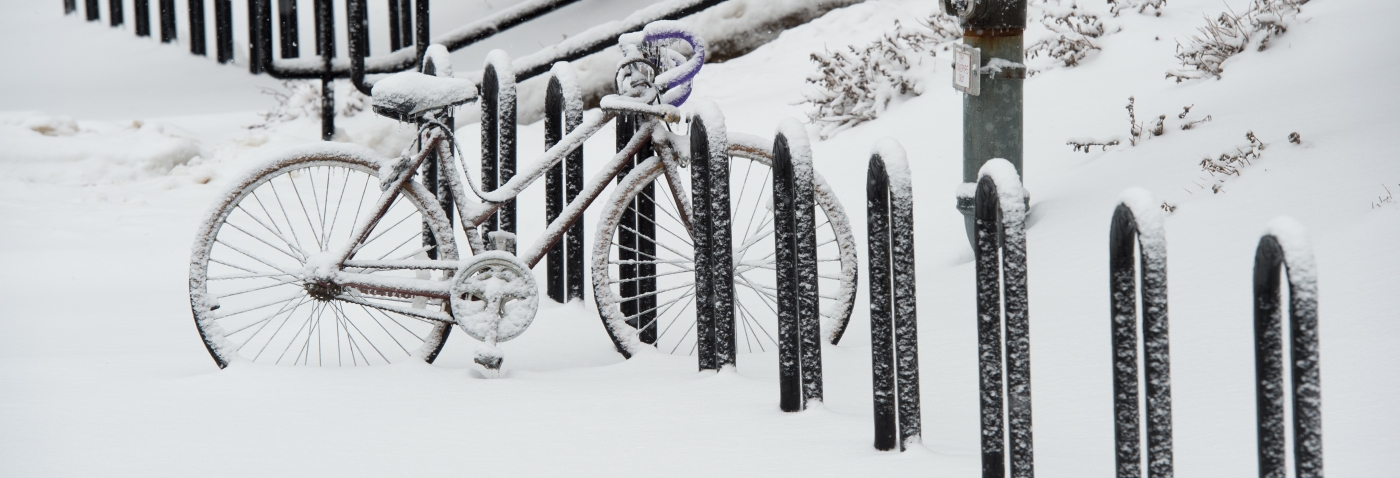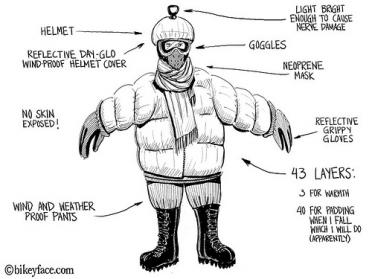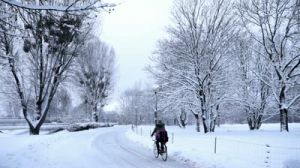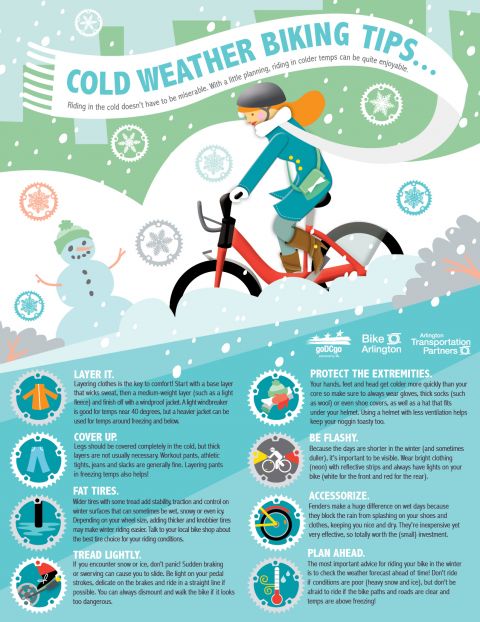College of Liberal Arts & Sciences

Winter Biking Tips
While winter biking may seem hard, there are plenty of easy measures you can take to make the most of the colder months. First, make sure that you don't put yourself in potential dangerous situations where you might get hurt. Monitoring road conditions, layering up, knowing the right materials to buy and some simple bike maintenance makes all the difference when you're battling the snow.
Safe Biking
- After a snowfall, snow is not often plowed back to the curb, so there are many places where a biker is going to be forced out into traffic by snow left in the bike lanes. This immediate curb area is where snow accumulates, gets plowed over, melts, freezes and generally becomes an uneven mess of ridges, road debris and ice. Seek out the pavement or just far enough away from the curb to stay off of this dangerous mix.
- If you are forced into the driving lanes be even more aware of cars and other vehicles. As with your spring-through-fall rides, you should always ride predictably. Limit any sudden or erratic movements and use hand signals when turning or changing lanes.
- Road conditions are variable so ride slowly. Don't try to keep up with traffic if you don't feel safe. As long as you are visible, drivers will be able to go around you and you can take your time.
- Learn the differences between riding on ice, loose snow and compacted snow. Be aware that ice can often be hard to see, take extra care when biking.
- Turn slowly and with caution. Turning quickly on an unseen patch of ice will result in an accident.
- When braking, use caution and try not to brake too quickly. If you have to slam on the breaks, try to use only your back brake for more stability.
- Leave early and make sure you have time to ride safely to your destination. If you are in a hurry, there is more of a chance you will get into an accident and hurt yourself. Also make sure you are not too tense while riding and feel comfortable so you can react smoothly to any obstacles during your ride.
- Visibility is important for safety (see clothing and bike sections below). Assume that you will be riding in darkness and have bright lights for both the front and back of the bike. Wear bright clothing and add strips of reflective tape.
- Don’t lock up next to the road before they plow the street!
 Clothing
Clothing
- Think layers! Wool or fleece under wind and waterproof layers will keep you amazingly warm during the coldest of mornings.
- Don't overdo it. Experienced bikers know that biking will make you sweat! Too many layers during a long bike ride can result in overheating which can make you really sick.
- Try to pick materials that don't trap moisture. Synthetic fabrics tend to trap moisture which is not only gross, but it can result in a pretty nasty rash. Wool is the best option, but if you're looking for something cheap a low-synthetic ratio option will do fine.
- Gloves are a must for winter biking. Wind proof mittens work best, but any glove that can keep your hands from getting chapped and wind-burnt will be a life-saver on those cold windy days. If you can afford them, handlebar mitts are a great way to save your hands.
- Boots and extra socks will come in handy when the weather is really wet. Even though you're not actually stepping in slush and snow, the spray from your bike will get your toes wet.
- If you can, adjust your helmet to fit a hat underneath it. If that's not an option, make sure you at least have something to protect your ears.
- Always wear a scarf to protect your neck and mouth on windy days. Breathing in cold air when you're pedaling hard will wreak havoc on your lungs.
 Bike
Bike
- There are two philosophies for winter biking: a single speed bike which needs little maintenance and can easily cut through slush and a mountain bike with wide, knobby tires for stability and traction. Keep in mind that on freezing days any bike might turn into a fixed gear bike no matter what.
- If you have a multi-speed commuter bike, there are easy steps you can take to soup up your bike for the winter, Consider buying winter treads for your tires and letting your tires ride on low pressure, which will make you feel more stable.
- If you live in an area where the snow plow comes infrequently, consider getting tire chains or studded tires so you can easily ride through loose or compacted snow.
- Make sure your bike has fenders on the front AND back. However, on really messy days make sure to clean out the area between the wheel and the fender as compacted snow can slow you down.
- Lights are a necessity. Look for the brightest bike lights you can find, preferably those that cast a wide viewing angle.It can get dark really fast in the winter and drivers have reduced visibility from ice and snow. The more visible you are the safer you are. Never wear black in the dark, and try to pick out clothes that are bright and reflective.
- Although this may seem counter-intuitive, leave your bike outside if it can be secured or in an unheated storage space. Bringing your bike into different temperatures will cause built-up ice to melt and corrode parts of your bike.
 More Tips:
More Tips:
REI has compiled a extensive list of tips and expert advice on winter biking: "Winter Bicycling and How to Enjoy It."
"Winter Bike Commuting: 12 Ride-Safe Tips" from Gear Junkie
"Winter ready: Tips to keep you riding through the cold" from Broken Spoke owner Michael Chamberlain
And "12 (not so) secret benefits of biking through the winter" from Tree Hugger by Toronto bike activist Yvonne Bambrick.
"The Procrastinator's Guide to Winter Bicycle Commuting" from Atlantic Cities.
Also from Tree Hugger: "Ride your bike in the city all winter."
Graphic Credit: Bike Arlington (Virginia)